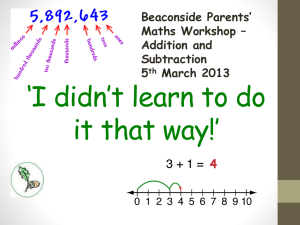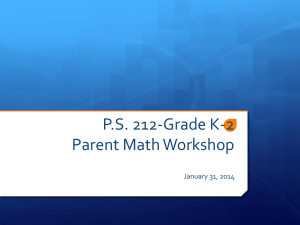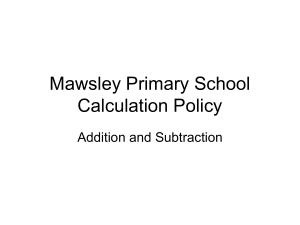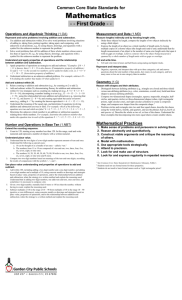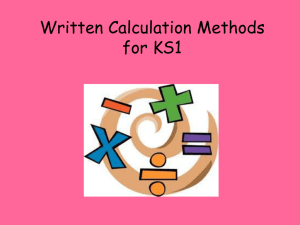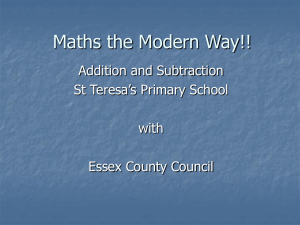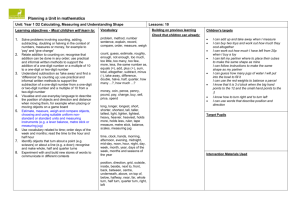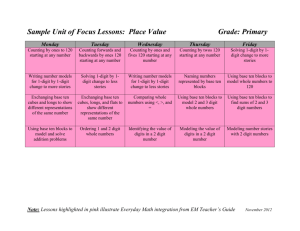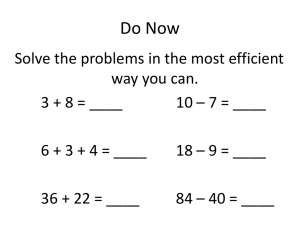Maths for KS1 and Reception Parents
advertisement
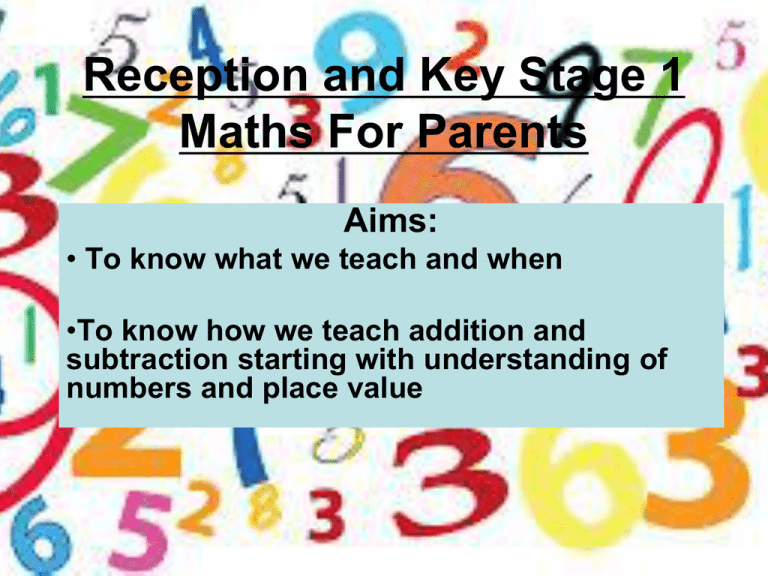
Reception and Key Stage 1 Maths For Parents Aims: • To know what we teach and when •To know how we teach addition and subtraction starting with understanding of numbers and place value What do we teach? Split into ‘Domains’ • Numbers and the Number System (including place value) • Addition and Subtraction • Multiplication and Division • Fractions • Measurement • Geometry (Properties of Shape) • Geometry (Position and Direction) • Statistics Number and place value (Reception leading onto year 1): • • • • • Count to and across 100 forwards and backwards in 1s Read and write the numbers Count in 2’s, 5’s and 10’s Identify 1 more/1 less Read and write numbers from 1 to 20 in numerals and words This would start in Reception, with an understanding of what a digit is made up of e.g. 5 is made up of….. 5 ‘ones’ 4 ones + 1 one 3 one + 2 one • Counting steps together up and down stairs: • What would be one more? One less? • Miss a number out when counting – which one have I missed out? • Saying the numbers of buses as they go past - who can say it first? • Counting lego in twos as they tidy away Numbers and place value (year 2): • count in steps of 2, 3, and 5 from 0, and in tens from any number, forward or backward • recognise the place value of each digit in a two-digit number (tens, ones) • identify, represent and estimate numbers using different representations, including the number line • compare and order numbers from 0 up to 100; use <, > and = signs • read and write numbers to at least 100 in numerals and in words • use place value and number facts to solve problems Numbers and place value (year 2): recognise the place value of each digit in a two-digit number (tens, ones) Which is more….. 23 Or 32 Hundreds Tens 2 3 Then when using Hundred numbers 123 would be: Ones 3 2 • identify, represent and estimate numbers using different representations, including the number line 0 10 20 30 40 50 60 70 80 90 100 compare and order numbers from 0 up to 100; use <, > and = signs The foundations for understanding addition and subtraction come from….. Understanding how single digit numbers are made up Knowing number bonds to ten Developing an understanding of place value Addition and subtraction (Reception) • Children say which number is one more/one less than a given number • Using quantities and objects they add and subtract two single digit numbers and count on or back to find the answer I’ve got 7 animals, how many is two more? What happens if I take 3 animals away? Addition and subtraction (Reception) • Introduced in Reception, but continually reinforced up to Form 6 • Number bonds to ten (use mental recall of addition and subtraction facts to 10) 7 + 3 = 10 7 Leads onto more complicated: 3 70+30=100 700+300=1000 Addition Expectations: Year 1: • read, write and interpret mathematical statements involving addition (+), subtraction (-) and equals (=) signs • represent and use number bonds and related subtraction facts within 20 • add and subtract one-digit and two-digit numbers to 20, including zero Year 2 • Using concrete objects and pictorial representations, including those involving numbers, quantities and measures. • recall and use addition and subtraction facts to 20 fluently, and derive and use related facts up to 100 • add and subtract numbers using concrete objects, pictorial representations, and mentally, including: - a two-digit number and ones - a two-digit number and tens - two two-digit numbers Addition • Stage 1: - after counting on (with fingers!) children then use their knowledge of number and use: The Empty Number Line 8 + 7 = 15 • 48 + 36 = 84 • Or: • Use a number line to answer: 53+24 86+17 149+38 •Stage 2: Partitioning Record steps in addition using partitioning: e.g. 47 + 76 47 + 7 6 Or basically jotting down the sums you’re doing in your head as you do them. 47 + 70 = 117 117 + 6 = 123 or…. 4 7+76= 40 + 70 = 110 7 + 6 = 13 110 + 13 = 123 Partitioned numbers are then written under one another: • Use partitioning to answer: 53 + 25 29 + 88 129 + 37 •Stage 3: Expanded Method in columns Write the numbers in columns. Adding the ones first: Gets the same answer – but children are encouraged then to move onto always adding the ones first. • Use the expanded method to work out: 36 + 58 46 + 83 •Stage 4: Column Method Used for adding more complex numbers including decimals. Subtraction • Stage 1: Empty Number Line – counting back 15 - 7 = 8 • 74 - 27 = 47 worked by counting back: •The steps may be recorded in a different order: • Empty number line – counting on: • Try using an empty number line, counting on or counting back to answer: 94 – 38 73 - 29 • Stage 2 Partitioning: • 74 – 2 7 74 - 20 = 54 - 7 = 47 • This requires children to subtract a singledigit number or a multiple of 10 from a twodigit number mentally. The method of recording links to counting on a number line • Stage 3 Expanded Layout, leading to column method Partitioned numbers are then written under one another: Example: 74 - 27 Example: 741 - 367 Useful Websites: http://www.woodlands-junior.kent.sch.uk/maths/index.html www.cheekymonkeyresources.co.uk/Downloads/maths/numbonds10/num bonds10b.htm http://www.bbc.co.uk/bitesize/ks1/maths/ http://www.ictgames.com/resources.html http://www.crickweb.co.uk/ks1numeracy.html https://www.gov.uk/government/publications/national-curriculum-inengland-framework-for-key-stages-1-to-4 https://www.gov.uk/government/uploads/system/uploads/attachment_data/ file/301256/2014_EYFS_handbook.pdf



